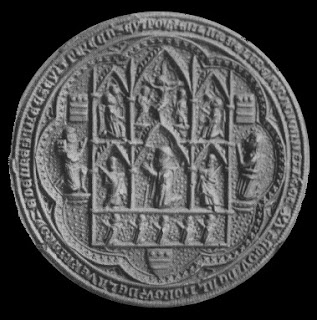Earlier this year (2022), a young boy called George was out with his metal detector in a field near Butley Priory and found this seal. He was 'tagging along' with his dad, who'd been detecting for 20 years. No doubt his dad had that special mixture of pride and envy!
Not much is left of Butley Priory, but what is left (the gatehouse*) is stonking. I'll complete this post when I've found my 20-year-old notes on the complete heraldry of the gatehouse (I hope I didn't chuck them away), but for now here are some pictures of it I took the other day, showing front and back.
 |
 |
* There are a few more ruins, actually, as you'll see from the excellent Wikipedia article.
The seal predates the gatehouse by a few years - the gatehouse being c.1300 and the seal, from the , mid-13th century, although it might be mid-to-late. You can find a full description of it on the wonderful finds.org, where these images are from. (finds.org will eat your day. Be warned.)
 |
 |
Left is the matrix; right an impression. The BVM, crowned and enthroned, with the Babe, nimbed, on her lap; she holds the orb, which he pats. Finds.org describes the orb as a sceptre, but it looks to me like an orb such as on Oseney's seal.
On her right, what looks like a fleur-de-lis virga (finds.org describes it as a f-d-l and its opposite as a lily, but ?). Above, a trefoiled canopy with two columns, atop which, a cross (and some sort of roof?). The cross cunningly becomes the start/end separator for the legend. In base, two trefoils either side of a trefoiled arch with a canon praying. There are pellets in four places, chief and base, marking or representing something.
The legend is a bit hard to read. The first bit is easy: S’PRIORIS ET CONVENT’ DE BVTTEL. But then... Finds.org gives it as O[or D]E AD CR [or A], with a possible interpretation of ‘canonico regulare’ (CR). But I think that's problematic - I've seen this nowhere else, and I'm not convinced that an Austin priory would describe itself thus. I find their second interpretation more convincing - that it's DE AD, being 'de Adae', of Adam the prior (who could be the figure at the bottom - that's not unusual). There was a Prior Adam - he was in office from c.1219 to 1235/6, when he was perhaps the prior of Butley sacked by Archbishop Edmund of Abingdon. That still leaves two letters - CA or CR to deal with - the 'canons of Augustine' or 'canons regular'. I'll need to do some research here, as I just cannot be convinced by this.
The later, 14th-century, seal, described by Birch, is no help:
816. Pointed oval: BVM, crowned, seated on a throne, with Babe, nimbed, on left knee; r. h. a fleur-de-lize sceptre, with birds billing in the foliage at the top, in an elaborately carved niche with buttresses at the sides, and canopy pinnacled and crocketed. In the field outside the niche, on each side a palm branch. In base under a carved arch with a window of tracery on each side, the Prior kneeling in prayer to the left. Legend: :S’.9E’.ECCE’.SC[E’.M]ARIE DE [:BV]TTELE
This seal is a great find. Sadly, it's up for auction, and not being given to a museum, but people need money...
Talking of which, if you have a few thousand to spare, you can hire Butley's gatehouse.


